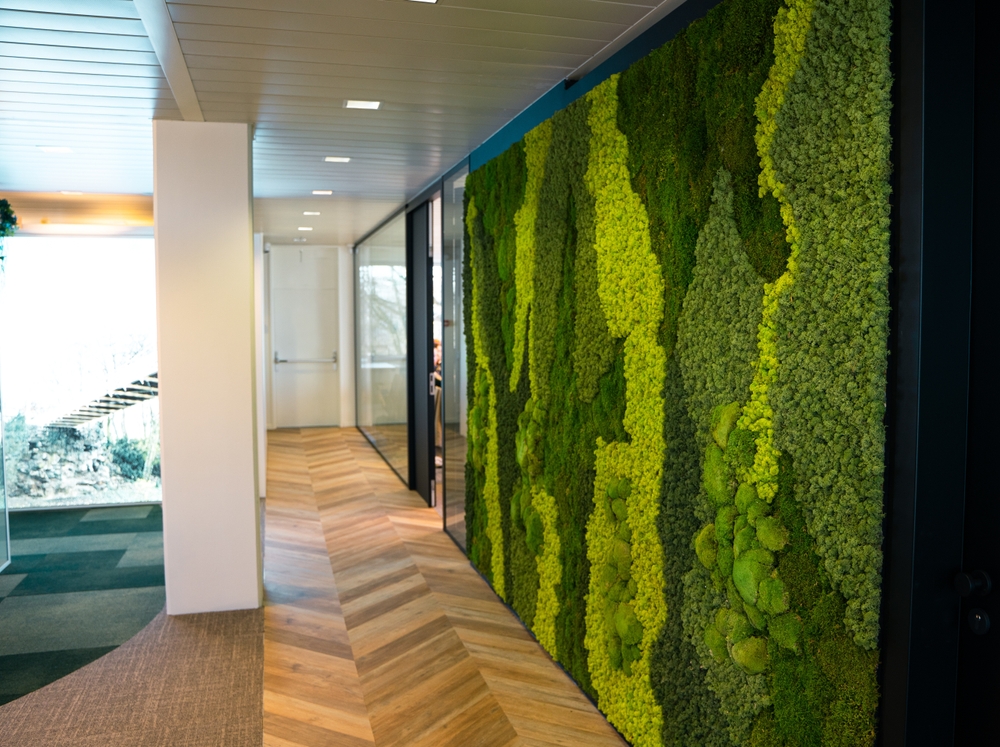This new bio-concrete lets moss grow on buildings. It filters air pollution and turns walls into living, breathing ecosystems.

Take a moment and look around your city. What do you see? Steel. Glass. Concrete. Endless walls and walkways stretching into the sky, built to last, built to dominate, built to separate us from the wildness we came from. But what if I told you those walls could breathe? What if that cold, gray concrete could soften, green, and come alive—not just as a metaphor, but for real?
This isn’t about tearing cities down. It’s about reimagining what they can be. It’s about turning dead space into living systems. It’s about something as simple and ancient as moss showing us a new way forward. Quietly, persistently, it grows where it’s not expected—on the sides of buildings, on the bases of turbines, in places long forgotten by nature. And in doing so, it asks us to reflect: What if growth didn’t always have to be loud? What if healing didn’t require demolition, just a shift in vision?
Breathing Life into Concrete—A New Kind of Green Revolution
Imagine walking through a city where buildings don’t just rise—they breathe. Where the grayness of concrete gives way to soft layers of green moss, filtering the air, cooling the space, and inviting nature back into our urban sprawl. This isn’t science fiction. It’s happening right now in the Netherlands, thanks to a pioneering effort by a Dutch startup called Respyre.
At the heart of this transformation is a material called bioreceptive concrete—a specially engineered surface that encourages the growth of moss. Unlike invasive climbing plants, moss uses rhizoids instead of roots, which means it can thrive on walls without damaging them. It’s gentle. But its impact? Profound. Moss does more than just add a layer of green. It converts CO₂ into oxygen, filters pollutants from both air and rainwater, and cools surfaces through a natural process called evapotranspiration—reducing the heat island effect that plagues many modern cities. And as an added bonus, this green layer becomes a habitat for micro-life, turning sterile walls into vertical ecosystems.
This innovation is not only about environmental benefit—it’s pragmatic, too. The mossy layer helps protect the underlying surface from weathering, extending the life of the structure. It’s low maintenance, graffiti-resistant, and can even be made using recycled concrete, making it a sustainable solution from start to finish.
Already being tested on balconies of social housing in Amsterdam and on the bases of wind turbines, Respyre’s moss-friendly concrete represents a quiet, yet radical shift in how we view our built environment. It’s not about tearing down to rebuild. It’s about letting nature in—one wall at a time.

Why Moss? The Unsung Powerhouse of Urban Nature
Moss may not command attention like towering trees or sprawling gardens, but in the context of urban sustainability, it’s a quiet powerhouse. With no roots and minimal need for soil, moss can thrive where other plants cannot—on vertical walls, shaded alleys, and aging infrastructure. Unlike most vegetation, it doesn’t need constant care. Its resilience makes it ideal for cities, where space is scarce and maintenance budgets are tight. This adaptability is precisely what makes it a game-changer for greening our cities without overhauling them.
Scientifically, moss punches well above its weight. It captures carbon dioxide, traps particulate matter, and absorbs nitrogen oxides—common urban air pollutants linked to respiratory issues. It also plays a role in stormwater management, soaking up rain and slowly releasing it back, reducing runoff and easing pressure on drainage systems. What’s often overlooked is that these benefits come without the complexities of root systems that could threaten buildings. That makes moss not just a sustainable option, but a practical one.
There’s also a psychological and social dimension. Exposure to greenery—even in small doses—has been shown to reduce stress, improve focus, and boost mental health. Imagine how our concrete-dominated neighborhoods would feel if they began to look more alive. Moss-covered surfaces could soften the harshness of cities and reconnect us, subtly but powerfully, to the natural world. And maybe that’s the real story here: this isn’t just about moss, or even architecture—it’s about healing the disconnection between human beings and the environments we create.

From Amsterdam to Innovation—Where Green Walls Meet Social Good
What makes Respyre’s approach even more compelling is that it’s not confined to theory or lab prototypes. It’s already finding a foothold in the real world. In Amsterdam’s Rivierenbuurt neighborhood, moss-covered balconies are appearing on social housing apartments—an intentional move that blends environmental innovation with social equity. These aren’t luxury eco-developments; they’re everyday homes, proving that sustainability doesn’t have to be exclusive. Everyone deserves access to cleaner air, cooler spaces, and greener surroundings—especially in dense urban areas where green space is often a luxury.
The application doesn’t end with housing. Respyre is also collaborating with Dutch renewable energy firm Eneco to explore moss integration on the bases of wind turbines. These typically unused concrete surfaces offer vast potential for environmental enhancement. By turning passive infrastructure into active ecosystems, the initiative doubles down on sustainability—clean energy generation from above, and air purification and cooling from below. It’s a smart, layered approach to maximizing utility without additional land use or energy input.
This kind of innovation reflects a shift in mindset: we can no longer afford to see infrastructure as static or lifeless. Every wall, every pillar, every balcony is an opportunity. By embedding nature into the very fabric of our cities, projects like these demonstrate that ecological restoration and urban development don’t have to be at odds. In fact, when done thoughtfully, they can reinforce one another, creating cities that serve not just function—but well-being.
Building for the Future—Aligning Innovation with Global Challenges
The urgency behind innovations like moss-growing concrete is rooted in more than aesthetic appeal—it’s a response to real, pressing global challenges. Urban areas are expanding rapidly, with more than half the world’s population now living in cities. This growth often comes at the expense of green space and biodiversity, increasing pollution and amplifying heat island effects. Traditional construction practices, while efficient in the short term, are major contributors to carbon emissions and resource depletion. In this context, turning buildings into living systems isn’t just clever—it’s necessary.
Bioreceptive concrete aligns naturally with sustainability targets outlined by global frameworks like the United Nations’ Sustainable Development Goals (SDGs), particularly those related to climate action, sustainable cities, and good health and well-being. By making infrastructure part of the environmental solution—rather than the problem—it creates a model that cities around the world can replicate and adapt. It’s a form of regenerative design: buildings don’t just do less harm; they actively contribute to ecological restoration.
What’s remarkable is that this progress doesn’t rely on new land, massive infrastructure shifts, or high energy inputs. It’s a low-impact, high-benefit solution that reimagines the materials we already use. And that’s the brilliance of it. Moss-covered concrete doesn’t demand a reinvention of city life—it enhances it. It proves that the future of urban living doesn’t have to be steel-gray and heat-soaked. It can be green, breathable, and full of life.

Rethinking What We Build—and Why
The story of moss-covered concrete is not just about new technology—it’s a mirror held up to the way we think about progress, permanence, and our relationship with the natural world. For generations, we’ve poured concrete as a symbol of control, of order, of separation from the unpredictability of nature. Cities were built to keep nature out. Trees were replaced with towers, and dirt was paved over with asphalt. But in doing so, we lost something vital—not just biodiversity, but a deeper connection to life itself. This innovation invites us to reverse that narrative. It doesn’t ask us to tear everything down. It simply asks us to see things differently—to view walls not as barriers, but as potential ecosystems, to imagine concrete not as a dead end, but as a starting point.
We now face global challenges that can’t be solved with the same thinking that created them. Climate change, mental health crises, urban pollution—these issues demand integrated solutions that consider both the physical and the psychological environments we inhabit. That’s what makes something as quiet and humble as moss so powerful. It doesn’t need a billboard or a marketing campaign. It doesn’t scream for attention. But it works—silently cleaning air, reducing heat, protecting buildings, and offering a subtle kind of beauty that reminds us we’re still part of something living. It reconnects us to rhythms that cities have long tried to silence. And maybe, in that reconnection, we start to heal—not just our ecosystems, but ourselves.
So now, we’re left with a question. Not just what kind of cities we want to live in—but what kind of legacy we want to leave behind. Will our skylines speak only of steel and ambition, or will they whisper of regeneration, cooperation, and humility? The walls around us don’t have to be blank. They can breathe. They can give back. They can grow. And maybe we can, too.


